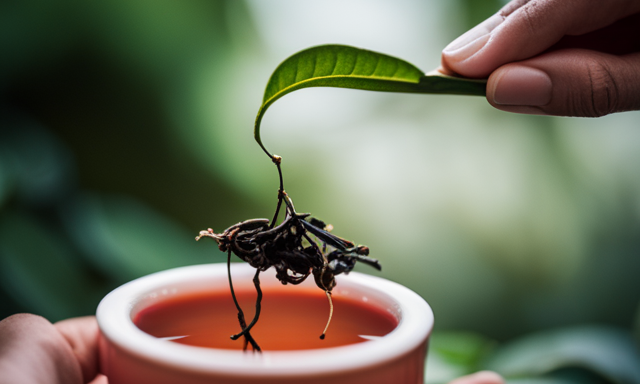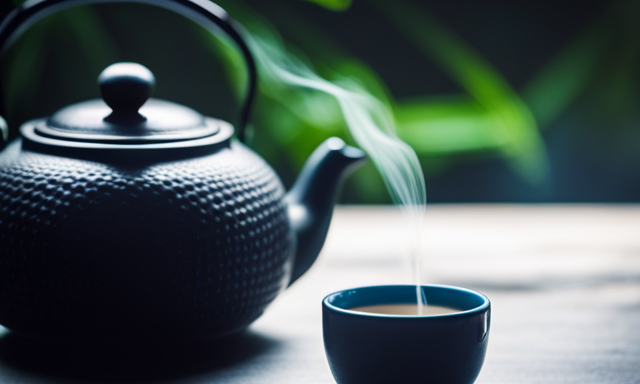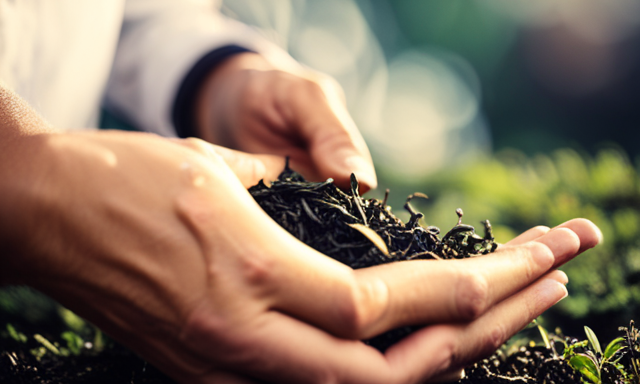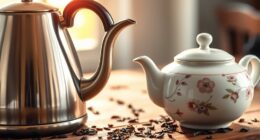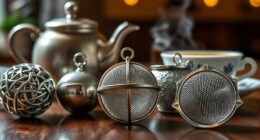As the saying goes, ‘A cup of tea is a cup of tranquility.’ And there’s no tea quite like oolong tea. So, let’s dive into the world of this exquisite beverage and explore the question: what part of the tea plant does oolong come from?
As a tea connoisseur, I’ve always been fascinated by the complex flavors and aromas that oolong tea offers. But to truly appreciate this tea, it’s important to understand its origins. Oolong tea comes from the Camellia sinensis plant, just like black, green, and white teas. However, what sets oolong apart is the specific leaf that is harvested.
In this article, we’ll delve into the art of tea harvesting and the unique characteristics of oolong tea. We’ll also explore the oxidation process that gives oolong its distinct flavor profile. From the different types of oolong tea to the traditional methods of preparation, we’ll cover it all.
So grab a cup of oolong tea, sit back, and join me on this journey through the fascinating world of this remarkable beverage.
Key Takeaways
- Oolong tea comes from the Camellia sinensis plant, like black, green, and white teas.
- The leaves for oolong tea are usually harvested from the topmost leaves and buds of the plant.
- Oolong tea is a traditional Chinese tea with medium oxidation levels.
- Harvesting techniques and oxidation play a crucial role in determining the quality and taste of oolong tea.
Overview of the Camellia sinensis plant
Did you know that oolong tea comes from the leaves of the Camellia sinensis plant? This plant is the source of various types of tea, including black, green, white, and oolong.
The Camellia sinensis plant is native to East Asia and is known for its unique flavor and aroma. Cultivation practices for this plant involve careful selection of suitable growing regions, as it thrives in specific climates and altitudes. Additionally, farmers employ various harvesting techniques to ensure the leaves are picked at the right time for optimal flavor.
The leaves are then processed to create different types of tea, including oolong.
Now let’s delve into the fascinating world of the harvesting process of tea leaves.
The harvesting process of tea leaves
During the harvesting process, you’ll experience the delicate art of selecting and gathering the leaves that ultimately create the exquisite flavor of oolong. Harvesting techniques play a crucial role in determining the quality and taste of the tea.
The first step involves carefully hand-picking the tea leaves, ensuring only the finest and most mature ones are chosen. This meticulous process ensures that the leaves retain their natural freshness and flavor.
Once harvested, the tea leaves undergo a series of processing steps to bring out the unique characteristics of oolong tea. These steps include withering, rolling, and oxidation, which contribute to the complex flavors and aromas that oolong is known for.
As we delve deeper into the world of oolong tea, you will discover the fascinating journey that these harvested leaves undergo to create this exceptional brew.
Introduction to oolong tea
Get ready to explore the world of oolong tea and uncover its unique flavors and aromas.
Oolong tea is a traditional Chinese tea that falls between green and black tea in terms of oxidation levels. Its production involves a meticulous process that requires skilled artisans.
The leaves used for oolong tea are usually harvested from the Camellia sinensis plant, specifically the topmost leaves and buds. Once harvested, the leaves undergo a withering process, where they are spread out and left to dry. Then, the leaves are rolled and shaped to release the tea’s distinct flavors. Finally, the leaves are dried and roasted to enhance their fragrance and taste.
Brewing oolong tea is considered an art, with different techniques and temperatures yielding various flavors. Understanding the overview of oolong production and the art of oolong tea brewing allows for a greater appreciation of this unique tea.
Now, let’s delve into the subsequent section to discover the unique flavor and aroma of oolong tea.
The unique flavor and aroma of oolong tea
Prepare to be amazed by the extraordinary flavors and delightful aromas that oolong tea has to offer your taste buds. Oolong tea is renowned for its unique flavor and distinctive aroma, making it a true delight for tea lovers.
The flavor of oolong tea can vary greatly, ranging from floral and fruity to woody and nutty, depending on the specific variety and processing techniques used. This variation in flavor is a result of the oxidation process, which gives oolong tea its characteristic taste.
The oxidation process in creating oolong tea is a fascinating one, as it involves partially oxidizing the tea leaves to achieve the desired flavor profile.
So, let’s dive into the next section and explore the intriguing oxidation process behind the creation of oolong tea.
Oxidation process in creating oolong tea
The mesmerizing metamorphosis of the oxidation process in crafting captivating oolong tea is a marvel to behold. This carefully controlled process, where the tea leaves are partially oxidized, imparts a unique flavor and aroma to oolong tea. The oxidation process begins as soon as the leaves are plucked from the tea plant. The leaves are spread out and exposed to the air, allowing them to wither and undergo enzymatic reactions. This crucial step determines the level of oxidation, which can range from 10% to 80%. The benefits of oolong tea are abundant, as it contains antioxidants that promote heart health, aids in weight management, and boosts metabolism. With the oxidation process complete, let’s delve into the specific part of the tea plant used for oolong tea.
The specific part of the tea plant used for oolong tea
Grown and nurtured with care, it’s the tender leaves of the tea plant that bring forth the exquisite flavor and aroma of oolong tea. Oolong tea is made from the Camellia sinensis plant, which is the same plant used to produce other types of tea like green and black tea. However, what sets oolong tea apart is the specific part of the tea plant that’s used – the leaves.
More specifically, it’s the partially oxidized leaves that give oolong tea its unique characteristics. These leaves undergo a unique oxidation process that lies between green tea and black tea, resulting in a complex and delicate flavor profile.
From the tea plant to the cup, oolong tea offers a delightful journey of taste and aroma. Now, let’s delve into the different types of oolong tea and their characteristics.
Different types of oolong tea and their characteristics
With a spectrum of flavors ranging from light and floral to rich and toasty, oolong tea unveils its diverse personalities through different types and their unique characteristics.
There are several types of oolong tea, each with its own distinct profile. For example, Tie Guan Yin oolong is known for its floral aroma and smooth, buttery taste, while Da Hong Pao oolong offers a bold and robust flavor with hints of roasted nuts. Other popular types include Oriental Beauty, which has a sweet and fruity taste, and Milk Oolong, which is creamy and smooth.
These varying flavors are achieved through different oolong tea production methods, such as oxidation levels and roasting techniques. As we explore the traditional methods of preparing oolong tea, we will discover the artistry behind this beloved beverage.
Traditional methods of preparing oolong tea
When it comes to oolong tea, the preparation process is just as important as the type of tea itself. Traditional brewing methods have been passed down through generations, ensuring that the unique flavors and aromas of oolong are fully experienced.
The oolong tea ceremony is a beautiful and intricate process that involves precise measurements, specific water temperatures, and carefully timed steeping. Each step is done with intention and focus, allowing the leaves to unfurl and release their full potential.
The result is a rich and balanced cup of tea that can be enjoyed sip by sip. As we move forward to explore the health benefits of oolong tea, we’ll see how this ancient practice can also contribute to our well-being.
Health benefits of oolong tea
Experience the amazing health benefits of oolong tea as you indulge in its rich and balanced flavors, sip by sip. Oolong tea is not only a delightful beverage but also offers numerous health benefits that make it a popular choice among tea enthusiasts.
Here are four ways oolong tea can enhance your well-being:
-
Boosts metabolism: Oolong tea contains polyphenols and caffeine, which can help increase your metabolism and aid in weight management.
-
Supports heart health: Regular consumption of oolong tea has been linked to a reduced risk of heart disease and lower levels of bad cholesterol.
-
Improves mental alertness: The combination of caffeine and theanine in oolong tea promotes mental alertness and focus, making it an ideal choice for a productive day.
-
Enhances digestion: Oolong tea can aid in digestion by improving gut health and reducing inflammation.
As you explore the health benefits and brewing techniques of oolong tea, you will also delve into the cultural significance of this remarkable beverage.
Exploring the cultural significance of oolong tea
The cultural significance of oolong tea can be seen in its role as a traditional beverage in many Asian countries, with Taiwan being the largest producer and exporter of this fragrant tea. Oolong tea has deep roots in Asian cultural practices and has been enjoyed for centuries. It holds historical significance as it has been a part of traditional ceremonies and social gatherings.
In countries like China and Japan, oolong tea is not just a drink, but a symbol of hospitality, respect, and harmony. Its preparation and presentation are often considered an art form, with specific rituals and techniques followed. Oolong tea is also associated with health benefits and is believed to promote relaxation, improve digestion, and boost metabolism.
This cultural reverence for oolong tea emphasizes its importance in Asian societies and highlights its integral role in their customs and traditions.
Frequently Asked Questions
How long does it take for oolong tea leaves to oxidize?
Oolong tea leaves typically take around 2-3 hours to oxidize. The oxidation process can be influenced by factors such as temperature, humidity, and the size and shape of the leaves.
Can oolong tea be brewed multiple times?
Yes, oolong tea can be brewed multiple times. By adjusting brewing techniques, you can extract different flavor profiles with each steeping. This allows you to fully explore the complex and evolving taste of oolong tea.
Are there any specific regions known for producing high-quality oolong tea?
Yes, there are specific regions known for producing high-quality oolong tea. These regions, such as Fujian in China and Taiwan, have ideal climates and soil conditions for oolong tea cultivation and employ traditional processing methods to create exceptional teas.
What is the caffeine content in oolong tea compared to other types of tea?
Oolong tea has a moderate amount of caffeine compared to other types of tea. It provides a gentle energy boost and has numerous health benefits, including improved digestion and weight management.
Are there any specific health benefits associated with drinking oolong tea?
Drinking oolong tea has specific health benefits, such as improving heart health, aiding in weight loss, and boosting mental alertness. However, it’s important to note the potential risks, including caffeine sensitivity and interactions with certain medications.
Conclusion
In conclusion, oolong tea is a truly remarkable beverage that originates from the Camellia sinensis plant. Its unique flavor and aroma, which are a result of the oxidation process, make it a favorite among tea enthusiasts.
While some may argue that oolong tea isn’t as well-known as green or black tea, its cultural significance and health benefits can’t be overlooked. So, next time you’re looking for a delicious and healthful drink, give oolong tea a try and experience its wonders for yourself.

